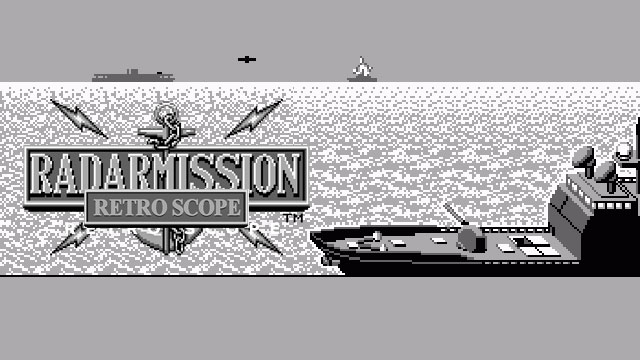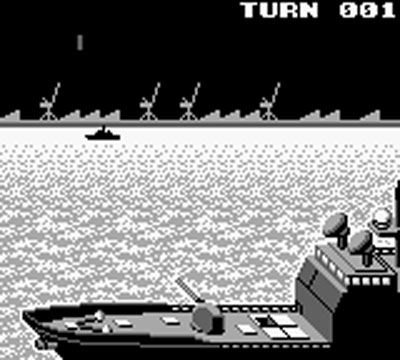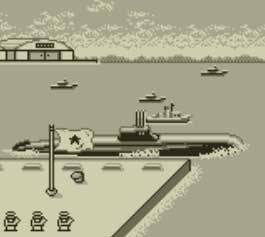
It’s funny what some extra coins in a Club Nintendo account can lead to.
I had just placed an order and had a couple hundred coins left, when I thought I’d look through what the service was offering this past December and see if anything might catch my attention. For a paltry 150 coins, the Game Boy Virtual Console title Radar Mission started to call out to me. It was a game that I’d seen and ignored numerous times on the 3DS eShop, but it always got me curious, for whatever reason. What was it? Who made it? This time, at such a small asking price, I decided it was time to delve a little deeper.
1990’s Radar Mission is actually a Nintendo-developed game that came from the mind of one Shigeru Miyamoto (whoever he is). Like Mole Mania, another forgotten Miyamoto title, Radar Mission is essentially a victim of obscurity. Not especially ambitious, profitable, or critically salivated over, it came and went in the blink of an eye. As anyone who plays video games knows, however, none of those factors necessarily dictate the quality of a given title. Some games just don’t get the love they deserved the first time up to bat, and Radar Mission is one of them.
The game has an A and B Game to play, along with a two player mode (that’s sadly been axed for Virtual Console). Anyone who has enjoyed a round or two of the board game Battleship (or played Salvatore’s sinking ships minigame in Wind Waker!) will appreciate Game A in Radar Mission. The basics of the game are the same: enemy ships are placed on a grid and must be destroyed by the player. Taking turns, the player and computer lob explosives at points on the grid attempting to take one another out. The catch is that neither side can see exactly where the other’s ships are. Only once a shot has landed can either combatant begin ferreting out where the enemy is located. Sink all the ships to win!

Game B is different. Players control a submarine from a third-person perspective, scrolling from left to right to take out enemy ships. Diving and surfacing allow the player to avoid and attack opposing craft, adding some strategy to the gameplay; it’s not as simple as firing volleys of munitions without pause. Knowing when to evade versus confront is key to surviving. This particular mode is decidedly action-oriented compared to the other, and is a nice change of pace from the more methodical Game A.
Both Game A and B are incredibly fun. A was my favorite, as it’s just so creative with the Battleship formula. There are different settings that can be tweaked to alter gameplay, including the ability to switch between three enemy commanding officers. Admiral Davis, Colonel Olds (he’s old, get it?), and Admiral Volcano represent the opposition, and besides having charming, quirky character designs, each offers their own attack patterns and levels of challenge. There are other little details that further add to the appeal. Whether it’s seeing a bigger splash in the water when a missed shot lands close to an enemy ship, or having an aircraft take off and join the fray, the game is packed with elements to discover.
As the aircraft I mentioned alluded to, this is not a straight game of blindly guessing where the enemy is and firing off shots. Radar Mission has a couple of different weapons to take advantage of to enliven the proceedings. Lucky Shots are special spaces on the grid that, once hit, will bestow the player with either a White or Black Star to use. White Stars attack multiple spaces at once, while Black Stars will sink any ship they hit, along with any adjacent ships, as well. Both open up another layer of strategy when playing Game A, and make Radar Mission that much more gripping.

Game B shouldn’t be forgotten, though, as it too provides some thoughtful additions to what could have been generic gameplay. In that mode, players can modify their submarine using points (which can carry over between rounds) to purchase three different power-ups. A submarine can be equipped with Prop Speed to move faster, Twin Shot to fire two torpedoes at once, and Power Sonar to display all enemy ships onscreen. All three can be activated in unison, or not at all, and finding the combination that works best for a player’s style is part of the fun.
It’s hard for some to believe that a game touting monochrome graphics could even be remotely aesthetically pleasing, but Radar Mission is exactly that. Nintendo made this game a real looker, boasting detailed visuals that depict the battles with surprising realism. From the water to the sight of explosives traveling through the air, Radar Mission backs its gameplay with equally potent graphics. The music is somewhat underwhelming by comparison, but its a respectable military-tinged soundtrack that suits the game perfectly. These sort of production values weren’t always common in Game Boy games, and it’s worth exploring Radar Mission just to see what Nintendo accomplished.
Radar Mission is still available for purchase on the 3DS eShop, and it’s a game that I wholeheartedly recommend everyone give a try. There are shades of other Nintendo series here, including Advance Wars. I think it’s also fair to state that the beginning of what would become Steel Diver are on display here. It’s pretty, it’s fun, and it’s inexpensive; for those wanting a new old game to play, Radar Mission will scratch that itch. I love finding forgotten Nintendo gems to play, but it’s a shame Radar Mission was forgotten to begin with.




 ShareThis
ShareThis






